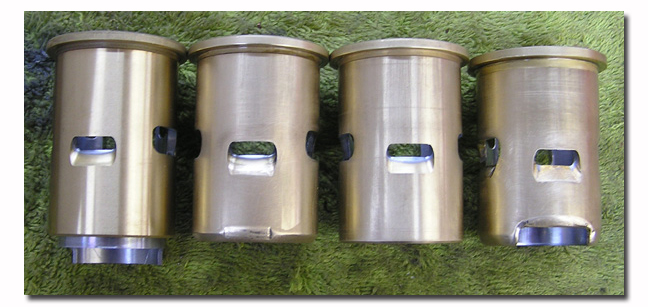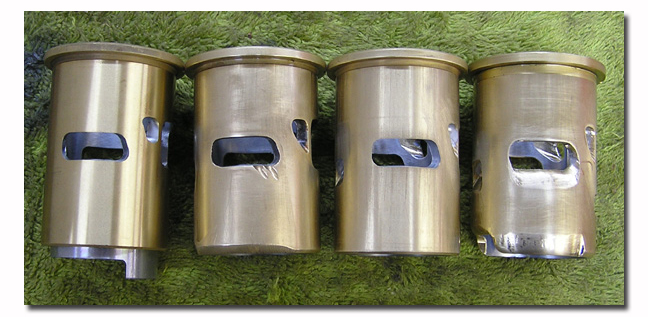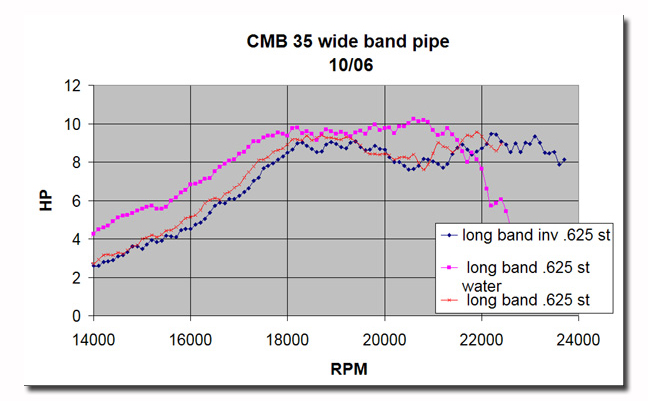Tech Article ...by Lohring Miller

Developing a CMB 35 Record Engine...see what is involved from testing stages to a 100 mph+ gas engine!
The introduction of the CMB 35 engine was met with enthusiasm in the model boating community. The engine was the first high performance 35 cc engine design available for model boats. The initial engines had some serious problems, however. The ABC piston and liner was an innovation for large gasoline engines, but nearly everyone running the engine had piston seizures. The company came out with a ringed piston running in a chrome brass liner to solve these problems. Below is a picture out of the stock engine.

Mike Bontoft and I have designed boats and developed engines to set speed records for radio controlled model boats. Mike currently is the only person in the world to hold a radio controlled gasoline powered, model boat official record of over 100 mph. His 109 mph 25cc record is the fastest a gasoline-powered boat has ever run. Several years ago we built an inertial dyno to test model boat engines. This type of dyno works by measuring the increase in rpm of a large flywheel driven by the engine. The power is calculated from this rpm change. We use a data logger and dyno software from Performance Trends. Mike machined and assembled the mechanical parts of the dyno. Below is a picture of the CMB with a test pipe on the dyno.

The engine was originally designed for endurance racing in Europe and was tuned for long life, high torque operation. We wanted to set straight line speed records so our very first changes were to raise the peak power rpm. We did this by changing the disc valve closing to 65° after top dead center and shortening the tuned pipe by removing the parallel center section and shortening the header. Below is the modified CMB pipe. Compare it to the pipe in the first picture.

Below is a picture of the stock and modified disk valves.

These simple modifications raised the power from 8 hp to over 11 horsepower and a maximum rpm from 16,000 to over 20,000 rpm. This was the most power we got from the engine. Below is a comparison of these modifications. The runs with the shorter CMB pipes also had modified liners and disk valves.

We did a series of liner modifications to also increase power. Below are the liners we tested. The stock liner is at left, the liner labeled “old mod” is next, the liner with stock ports and exhaust modifications like the “old mod” liner (called “Tidewater exh mod”) is next, and the liner labeled “new mod” is last. I don’t know what the purpose of the slot below the exhaust port in the last liner is. If it was to oil the piston to prevent seizure, it didn’t work.



The “old mod” liner (2nd from left) had raised exhaust timing, flat topped boost ports and the two cuts in the front of the boost ports. The “Tidewater exh mod” liner (3rd from left) had the same exhaust modifications, but stock transfers that are angled slightly up. The “new mod” liner ( 4th from left) had ‘streamlined’ transfer ports and a cut out where the liner partially blocked the intake passage. Unfortunately, the “new mod” liner seized on its first run, with the sudden power drop at 21,000 rpm. All the other graphs show data that is the average of two or more runs. Even so, it is interesting that the “old mod” liner has better high rpm power. This is consistent with the latest RC car liners with similar transfer modifications on factory engines. We suspect that while most of the transfer flow is directed across the top of the piston and collides in the center of the cylinder, the cuts direct some flow up the cylinder. This intercepts mixture from the boost port that otherwise might flow out the exhaust. Below is the power of the various liners on the same pipe.

Because of available propellers, we needed even more rpm. We began a program to develop a tuned pipe to accomplish this. I built a series of test pipes in very light stainless steel sheet silver soldered together. They each lasted long enough to test basic design parameters. I then built two more durable pipes that we actually ran.
First a quick review of tuned pipe theory. The pipe produces two pressure waves at the exhaust port. The first, a low-pressure wave, is created by the diffuser section of the pipe when the exhaust port opens. It reaches its lowest pressure when the piston is at bottom dead center and helps draw fuel up through the transfers. The second wave is a high-pressure pulse created by the baffle cone that arrives just before the exhaust port closes and supercharges the cylinder. There are several types of diffuser in use. The simplest is a single cone that tapers up from the header diameter to the maximum pipe diameter. This has evolved into multi cone diffusers that look like a roughly shaped horn. These two styles are shown in the picture below. The top two pipes have multi cone diffusers on the left side of the maximum diameter section, while the bottom pipe has a straight cone diffuser. The top pipe’s diffuser has a higher horn coefficient than the second pipe. That is, it expands more suddenly then the diffuser section of the second pipe. All these pipes have the same maximum diameter, the same baffle cone and the same tuned length.

The tuned length of these pipes was designed to produce best power around 22,000 to 24,000 rpm, with the top pipe producing the lowest power and the bottom pipe producing the highest. The top pipe should have the broadest power band while the bottom pipe should have the narrowest. Below are the actual test results on the modified CMB 35. Nearly all the lines represent the average of two or more runs. Where there is scatter from a single run, an average line is drawn through the points.

The problem with the actual pipes on a real engine is that they produce two power peaks and the second peak is probably higher than 24,000 rpm. All the pipes turned out to be too short. This happened because I used the wrong average temperature in the pipe design program. The power band on the pipe with the straight cone diffuser is so narrow and the trough is so deep that the engine won’t rev much beyond the first peak. The pipe with the 1.2 horn coefficient diffuser looks like it has a narrower power band at the high rpm peak, but it’s hard to tell since the peak wasn’t reached. The pipe with the 1.4 horn coefficient showed the most promise as a high rpm pipe. It is interesting to see how water injection into the header of the 1.4 horn coefficient pipe affects the power. This cools the exhaust and is the same as making the pipe longer.
Two more pipes were made to a longer tuned length with the same 1.4 horn coefficient diffuser section. The first was lengthened by lengthening the maximum diameter band section, and the second was lengthened by lengthening the baffle cone. The length to the stinger was kept the same on both pipes. A comparison of these pipes is shown on the graph below.

As you can see, there is very little difference even though the tests were run with both .600 and .625 diameter stingers. The dark blue line is a test on the shorter pipe tested before but with a larger stinger. It has lower power than the longer pipes except above 23,000 rpm. We have also reduced the trough in the power curve by adjusting the carburetor fuel delivery with the high and low range needles. Further testing on the wide band version of the longer pipes is shown below.

Again it is interesting to see that an inverted stinger (blue line) doesn’t significantly reduce power and that water injection really helps at lower rpm. Actual testing of the long cone pipe in a boat produced equally interesting results. One graph of rpm versus time is shown below.

The first plateau is reached at 20,000 rpm with the water injection on. Turning the water injection off allows the engine to rev to 23,000 rpm. These rpm readings agree well with the points where the long cone pipe begins to lose power. The space between each vertical line represents one second and the boat is going around 50 mph at 12,000 rpm in this test. It takes much less than ½ second to accelerate to over 80 mph with the water injection on. The rpm remains flat indicating that the boat is not gaining speed after reaching 23,000 rpm. In this case the pipe is governing the maximum rpm and the prop pitch limits the maximum speed. If the second plateau had been sloping up the boat would be still accelerating. It took around four seconds to travel the length of our test pond.
All this high rpm running was very hard on the engine. As well as the seized pistion mentioned above, we pounded the wrist pin hole on both the piston and rod out of round after a series of runs to as much as 25,000 rpm. This is not too surprising since 25,000 rpm represents a piston speed of over 5,700 feet per minute. This is more than any current racing engines can run for long. We limited the peak rpm in all the runs after that to below 23,000 (still 5,200 feet per minute) by running a slightly longer tuned pipe. We found that the crankshaft was flexing causing flywheel strikes in the magneto. The ignition developed a miss at high rpm as well. Mike solved these problems by making a new front plate with an extra bearing that adapted an electronic ignition system to the engine. Below is a picture of the engine with the new front plate. This modification and the lighter custom pipe saved about 1 pound.

Finally we put everything together in Mike’s innovative hydro. Below are pictures of the boat and the data from one of the high speed runs. The GPS speed lags the actual boat speed due to the slow GPS update rate. We raised the old 35cc class record from 82 to over 102 mpg, but it wasn’t easy.




